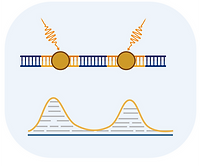Systems Bio
Next Generation Sequencing
Next-Generation Sequencing (NGS) technologies enable the profiling of the genomic and epigenomic landscapes of living cells. Systems Bio possesses expertise in several NGS technologies, including the following:

RNA-Seq (RNA Sequencing):

RNA-Seq technology measures gene expression in cells by quantifying the abundance of messenger RNA (mRNA). This technology is an incredibly powerful and widely utilized approach for comprehensively profiling gene expression patterns, offering valuable insights into cellular function and regulation.
How RNA-Seq data helps drug discovery:
RNA-Seq supports drug development research through multiple applications. The most widely adopted approach involves detecting aberrations in gene expression within diseased tissues. By comparing transcriptional profiles of healthy and diseased samples using differential expression analysis, researchers can identify transcriptional abnormalities associated with specific diseases.
Beyond differential expression analysis, RNA-Seq offers additional strategies for narrowing down drug target candidates. For instance, in targeted therapies, it is essential to evaluate the expression levels of a prospective target gene in the tissue of interest before initiating preclinical studies. If the target gene is not expressed or expressed at very low levels in the relevant tissue, the feasibility of the study may need to be reconsidered. Conversely, if the target gene shows high expression but is also abundantly expressed and critical for the functionality or viability of healthy cells, additional considerations for safety and toxicity become imperative.
WGS (Whole Genome Sequencing):

Whole Genome Sequencing (WGS) is a comprehensive, genome-wide technology that enables the identification of genetic mutations across the entire cellular DNA. By sequencing the full DNA sequence, WGS allows researchers to detect a wide range of genetic variations, including single nucleotide polymorphisms (SNPs), insertions, deletions, and structural variants. This high-resolution approach provides valuable insights into the genetic basis of diseases, offering the potential for discovering novel biomarkers, understanding disease mechanisms, and advancing personalized medicine.
How WGS data helps drug discovery:
Whole Genome Sequencing (WGS) aids in identifying various types of mutations, including structural variations (such as copy number alterations, translocations, and inversions), small indels (short insertions and deletions), and point mutations (such as single nucleotide polymorphisms - SNPs), all of which are associated with diseases, particularly cancer. The genes impacted by these mutations can serve as targets for further investigation, potentially leading to the development of novel therapeutic interventions.
ATAC-Seq (Assay for Transposase-Accessible Chromatin with Sequencing) :

ATAC-Seq technology identifies open regions within the DNA chromatin. These open regions are accessible to transcription factor proteins and are activated for transcription. In contrast, closed chromatin regions—wrapped around nucleosome complexes—are not accessible and remain inactive in terms of transcription. By analyzing these patterns, ATAC-Seq technology determines the epigenetic signature of the cells
How ATAC-Seq helps drug discovery:
ATAC-Seq technology supports drug discovery in ways similar to RNA-Seq. One limitation of RNA-Seq is that transcriptional changes are highly dynamic, can occur rapidly, and are sensitive to experimental conditions and cellular stress. In contrast, epigenetic signatures are more stable and change more slowly. As a result, ATAC-Seq is less sensitive to sudden fluctuations, providing a more persistent and reliable view of the genetic landscape
ChIP-Seq (Chromatin Immunoprecipitation Sequencing):

ChIP-Seq is a high-throughput sequencing method used to profile epigenetic signatures. Similar to ATAC-Seq, it analyzes the DNA chromatin state but operates differently. DNA is wrapped around histone proteins, which are modified by the addition of acetyl and methyl groups. These modifications can indicate transcriptional activation or repression of specific regions. Histone modification ChIP-Seq identifies these post-translational modifications, revealing activated or repressed DNA regions. A related technique, transcription factor (TF) binding ChIP-Seq, identifies DNA regions bound by specific TF proteins.
How ChIP-Seq data helps drug discovery:
Similar to ATAC-Seq, histone modification ChIP-Seq profiles the overall epigenetic signature of the chromatin. Unlike ATAC-Seq, histone modification ChIP-Seq identifies both activated and repressed regions. Transcription factor (TF) binding ChIP-Seq, on the other hand, identifies the genes regulated by a particular TF, revealing its downstream targets
Capture-C (Chromosome Conformation Capture):
Capture-C technology is another advanced epigenomic sequencing method that provides valuable insights into chromatin interactions. Unlike ATAC-Seq and ChIP-Seq, which focus on profiling chromatin accessibility and histone modifications, respectively, Capture-C identifies the regions of DNA that physically interact with specific regions of interest. This technology allows researchers to explore the three-dimensional structure of the genome and better understand how distant genomic regions may influence gene regulation and cellular processes.

How Captue-C data helps drug discovery:
Many regions of the DNA continuously interact with each other to regulate gene expression. Capture-C helps identify DNA regions that interact with a specific genomic region, such as one containing a gene of interest. This can provide insights into the potential success and specificity of genetic interventions. Additionally, Capture-C can assist in designing viral vectors for gene therapy by helping to construct optimal enhancer/promoter sequences.